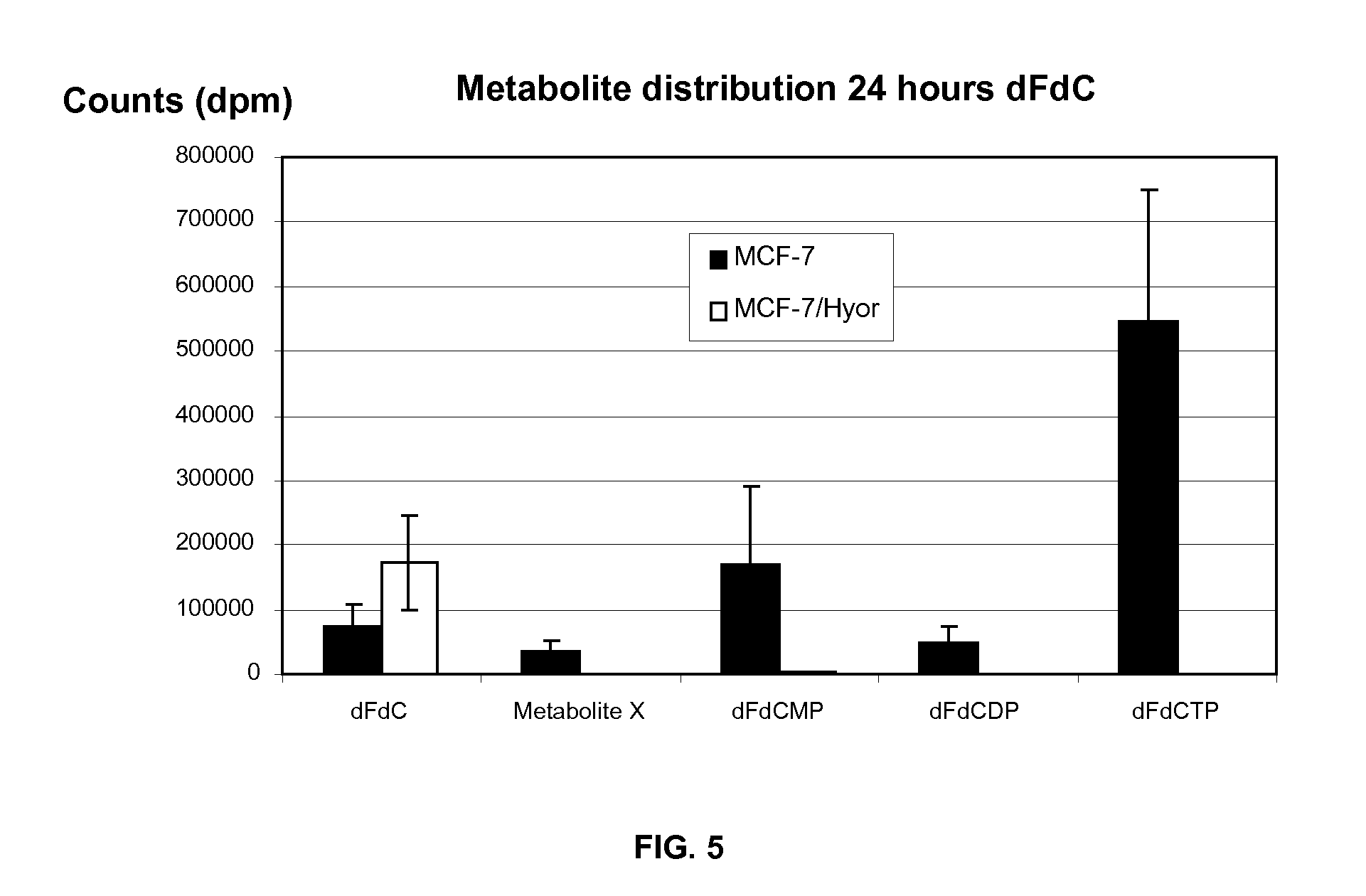Anti-cancer combination therapy
a combination therapy and anti-cancer technology, applied in the field of combination therapy, to achieve the effect of restoring the cytotoxicity of these drugs
- Summary
- Abstract
- Description
- Claims
- Application Information
AI Technical Summary
Benefits of technology
Problems solved by technology
Method used
Image
Examples
example 1
Materials and Methods for In Vitro and Cellular Experiments
Reagents and Materials
[0122]TPi, 5-chloro-6-(1 [2-iminopyrrolidinyl]methyl)uracil hydrochloride, a potent inhibitor of TP, is described in literature (Fukushima M. et al., Biochem Pharmacol 2000; 59:1227-36). 5-Fluoro-5′-deoxyuridine (5′DFUR), 5-trifluorothymidine (TFT), thymidine (dThd), 5-fluoro-2′ deoxyuridine (FdUrd), 5-chloro-2′-deoxyuridine (CIdUrd), 5-bromo-2′-deoxyuridine (BrdUrd), 5-iodo-2′-deoxyuridine (IdUrd), and 5-fluorouracil (5FU) were purchased from Sigma (St-Louis, Mo.). Gemcitabine (dFdC) and cladribine were obtained from Prof. McGuigan (Cardiff, UK). [CH3—3H]-Thymine, [6-3H]-TFT, [2-14C]-TF-thymine, [6-3H]-BrdUrd, [6-3H]-FdUrd, [6-3H]-dUrd, [5-3H]-uracil, [6-3H]-5FU and [5-3H]-dFdC were obtained from Moravek Biochemicals (Brea, Calif.) and [CH3—3H]-dThd from MP Biomedicals (Solon, Ohio). Plasmocin was purchased from Invivogen (San Diego, Calif.). The antibody against β-actin was obtained from Sigma, the po...
example 2
Identification of M. Hyorhinis Infection in MCF-7 / HYOR Cell Cultures
[0132]Productive infection of MCF-7 cells with M. hyorhinis was confirmed by a species-specific PCR, which detected a PCR-band of 616 bp in the MCF-7 / HYOR cell extracts (FIG. 1A). No PCR-bands were found in the uninfected MCF-7 cell extract or in the non-template control. Infection of MCF-7 cells with M. hyorhinis was also evaluated by staining the cellular and bacterial DNA with the Hoechst 33342 dye (FIG. 1B). Nucleic acid-rich particles can be visualized in the cytosol of the MCF-7 / HYOR cells and MCF-7 / HYOR cells that were treated for 3 days with TPi (10 μM) indicating that TPi is not inhibitory to the growth of M. hyorhinis in MCF-7 cell cultures.
example 3
Detection of Human TP in MCF-7 and MCF-7 / HYOR Cell Extracts and Cell Culture Medium
[0133]Western blot analysis using a polyclonal antibody against human TP did not detect the protein in extracts of MCF-7 and MCF-7 / HYOR cells (FIG. 2). However, human TP could be abundantly detected in extracts from MCF-7 cells that were transfected with the human TP gene. This confirms that MCF-7 cells do not express human TP and indicates that M. hyorhinis infection does not induce the expression of human TP in MCF-7 cells. Also, human TP was not detected in the medium of uninfected MCF-7 and M. hyorhinis-infected MCF-7 / HYOR cells (data not shown). The polyclonal antibody used in this assay, did not show any cross-reactivity with the mycoplasmal TP present in the culture medium of MCF-7 / HYOR cells.
PUM
| Property | Measurement | Unit |
|---|---|---|
| concentration | aaaaa | aaaaa |
| total volume | aaaaa | aaaaa |
| pH | aaaaa | aaaaa |
Abstract
Description
Claims
Application Information
 Login to View More
Login to View More - R&D
- Intellectual Property
- Life Sciences
- Materials
- Tech Scout
- Unparalleled Data Quality
- Higher Quality Content
- 60% Fewer Hallucinations
Browse by: Latest US Patents, China's latest patents, Technical Efficacy Thesaurus, Application Domain, Technology Topic, Popular Technical Reports.
© 2025 PatSnap. All rights reserved.Legal|Privacy policy|Modern Slavery Act Transparency Statement|Sitemap|About US| Contact US: help@patsnap.com



